As Texas summer hangs on and gardens burst with color, why let the party fizzle when fall arrives? In Texas, the season runs long.
With smart picks and timing, you can keep flowers blooming through the first blue northers… whether you’re in Amarillo, Austin, Houston, or Harlingen.
⬇️ Plant these late-blooming, Texas-tough beauties now and enjoy waves of vibrant petals right through the first cool fronts. ⬇️
How to use this guide: Each plant includes quick highlights, then short notes for Texas timing, water/soil, and where it shines.
For planting windows, read as a rule of thumb: North TX (Panhandle, Red River, DFW), Central TX (Hill Country, I-35 corridor), and South TX (Gulf Coast, RGV).
Annuals
1. Zinnia (Zinnia elegans)
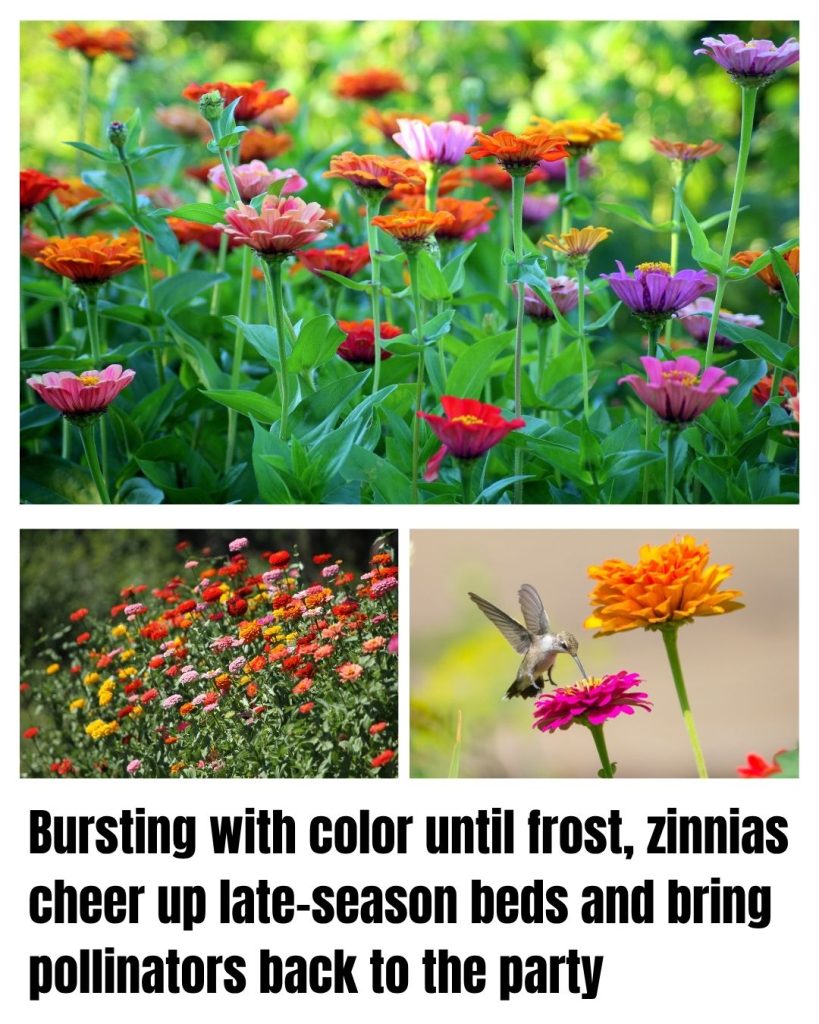
- Vibrant daisy-like blooms in every hue, from hot pinks to sunrise orange.
- Nonstop color from late summer until first frost.
- Pollinator magnet for butterflies and native bees.
Zinnias are born for Texas sun. The flowers sit on sturdy stems that shrug off heat and put on a show until cold finally taps them out.
Mix heights for a meadow look, or go with compact series for neat borders. Deadhead weekly to push new buds.
Texas timing: North TX; set transplants late July to August for fall bloom; Central TX; late July through early September; South TX; August into mid-September. Sow seeds 2–3 weeks earlier than transplant windows if you prefer direct seeding.
Water & soil: Needs full sun and well-drained beds. Water deeply, letting the top inch dry between soakings. Space for airflow to reduce powdery mildew during humid Gulf spells.
Where it shines: Cutting gardens, curb strips, kids’ gardens, and big show beds that need reliable color fast.
2. Cosmos (Cosmos bipinnatus & C. sulphureus)
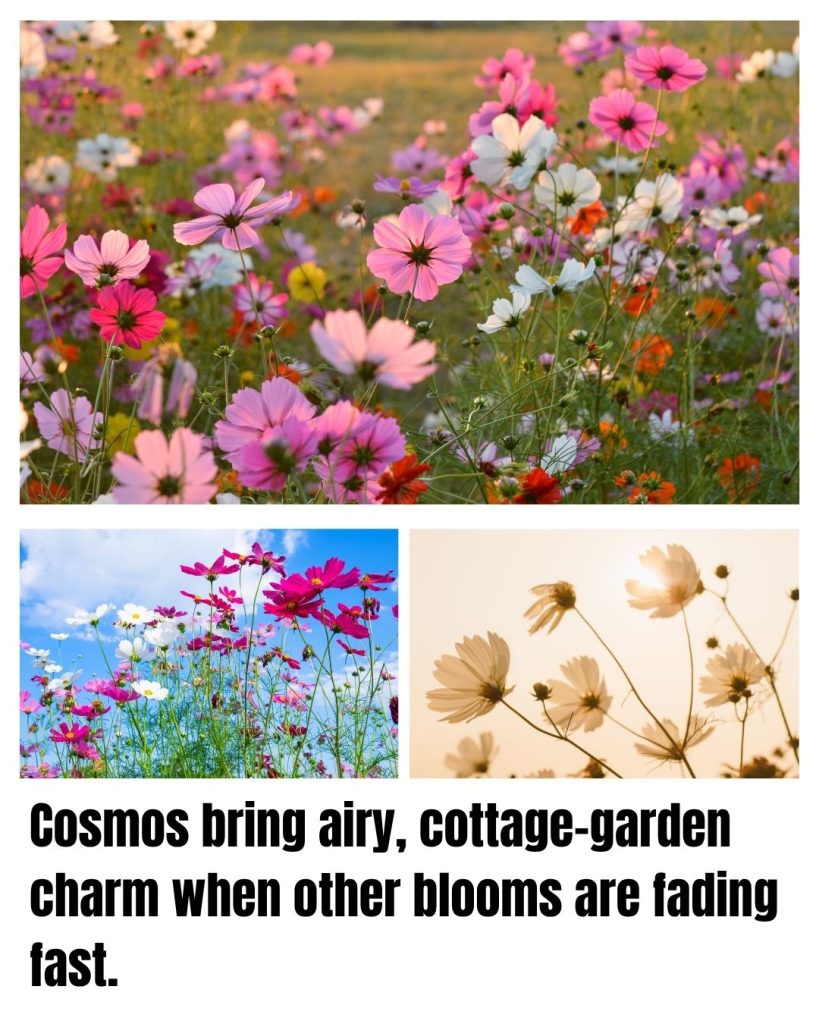
- Airy, fern-like foliage with clouds of daisies.
- Long bloom from late summer to frost.
- Drought tolerant and easy from seed.
Texas gardeners should lean on both species: C. bipinnatus brings pinks and whites; C. sulphureus brings heat-loving oranges and yellows that handle August like a champ. Deadhead lightly to keep the show going without reseeding everywhere.
Lone Star timing: North TX; direct sow in late July-August; Central TX; August-early September; South TX; August-September. In extreme heat, shade cloth at midday speeds establishment.
Water & soil: Average soil is fine; too much nitrogen = floppy stems. Water to establish, then cut back. Full sun is best, but they’ll tolerate bright open shade in the afternoon.
Where it shines: Cottage borders, wildlife strips, and anywhere you want movement and a soft, romantic look.
3. Celosia (Celosia cristata & C. plumosa)
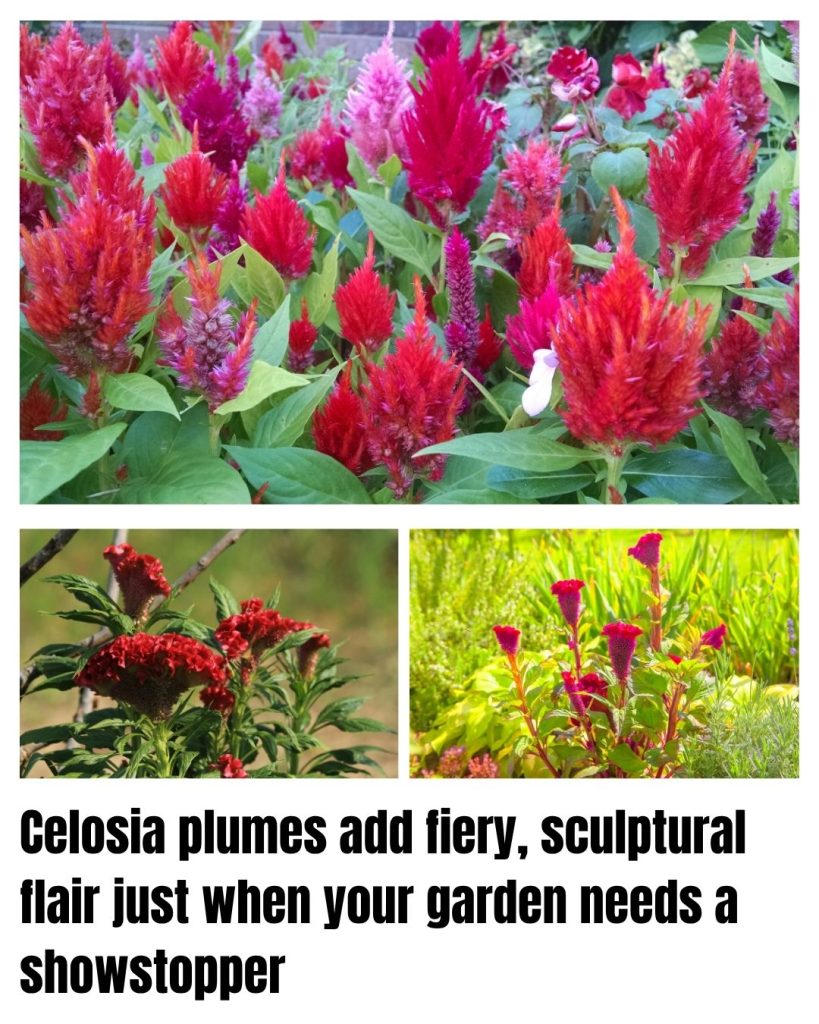
- Flame-like plumes and coral crests in bold colors.
- Heat lover that laughs at triple digits.
- Great cut or dried for long-lasting displays.
Celosia is a sculptural anchor for late beds. Use plume types for vertical lines and crested types for funky, ruffled texture. Pinch young plants once for bushier growth.
Texas timing: Set transplants mid-July through early September statewide. In the Valley and Coast, you can push later, but allow 8-10 weeks for flowering.
Water & soil: Full sun, lean soil, good drainage. Overwatering or heavy fertilizer reduces color intensity and causes lush, weak growth.
Where it shines: Hot foundations, festival planters, and mixed annual borders with salvia and ornamental peppers.
4. Globe Amaranth (Gomphrena globosa)
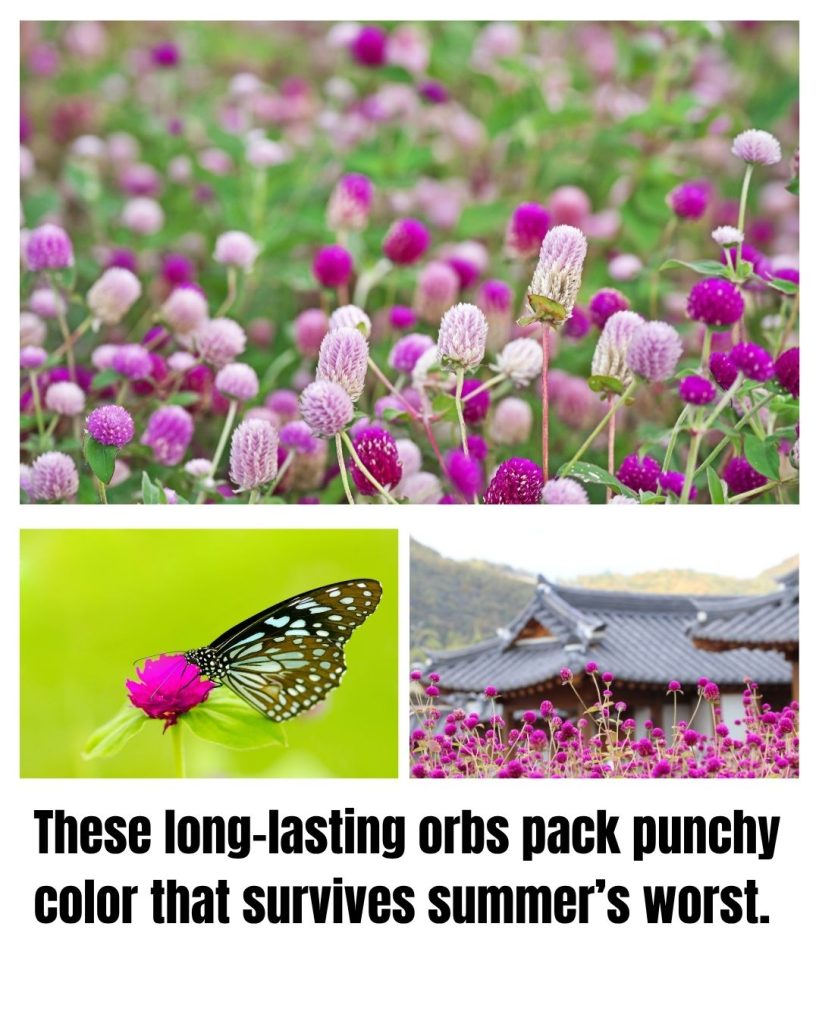
- Paper-like pom-poms in magenta, pink, and white.
- Heat and drought tough for long Texas summers.
- Compact habit that stays tidy.
Gomphrena brings cheerful dots of color that hold even in dry wind. It’s a classic partner with lantana and fountain grass and a champion in school gardens where watering is sporadic.
Texas timing: Transplant from July through September statewide. Direct seeding is easy; scratch soil lightly and keep moist for 7–10 days.
Water & soil: Full sun and drainage are key. It tolerates alkaline Hill Country soils without complaint. Water weekly until established, then every 10–14 days in drought.
Where it shines: Edging, low containers, mailbox plantings, and drought-rescue color in late summer.
5. Tithonia (Mexican Sunflower)
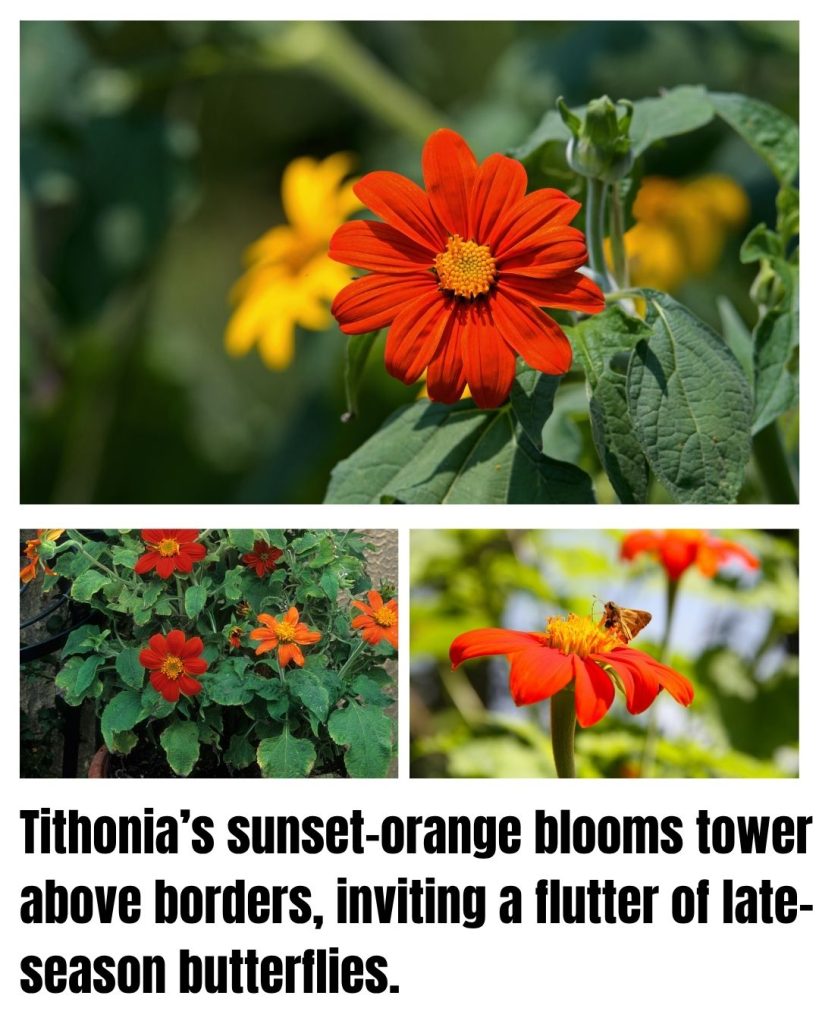
- Fiery orange daisies that read from across the street.
- Monarch magnet during fall flights.
- Tall and bold for the back of beds.
Tithonia is pure drama. Plants hit 4–6 feet, then explode with sunset-orange blooms. Give it elbow room and a stake in windy sites. Clip spent flowers to keep new buds racing.
Texas timing: Transplant July–August in North and Central TX, August–early September on the Gulf and in the Valley.
Water & soil: Full sun, lean soil, and moderate water. Too much fertilizer makes floppy stems. Mulch to stabilize moisture.
Where it shines: Pollinator alleys, fence lines, and as a fall focal point with blue salvia and purple fountain grass.
6. Marigold (Tagetes spp.)
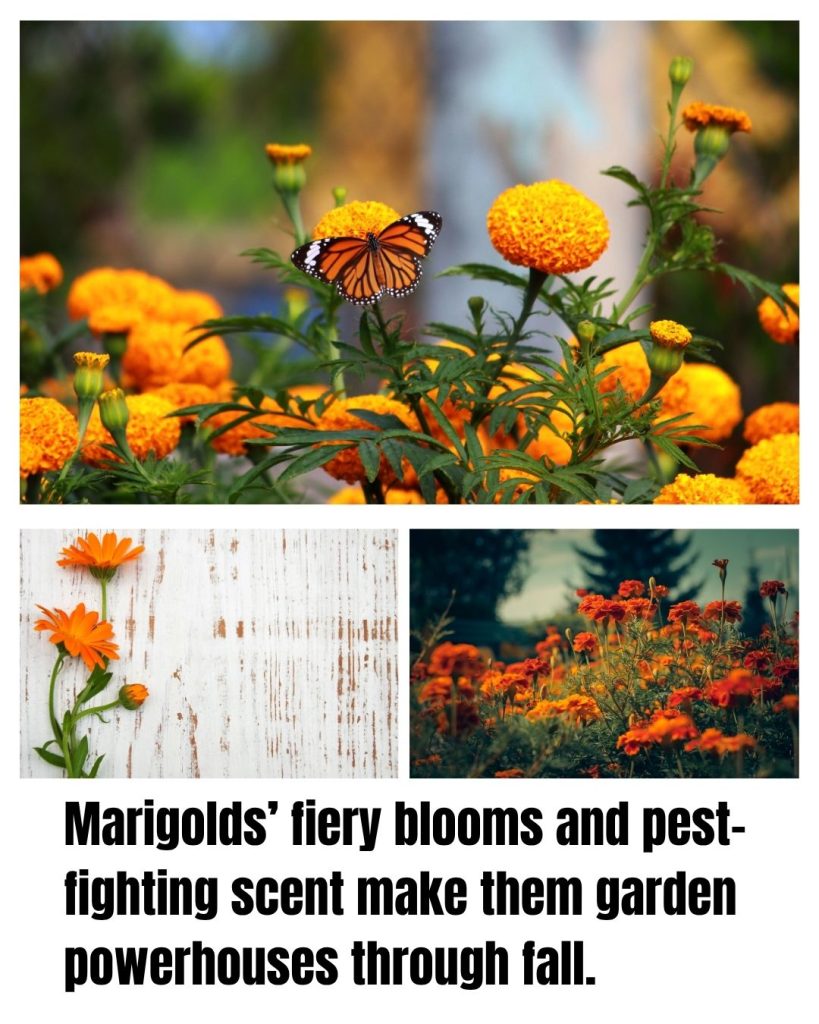
- Firecracker color in gold, orange, and bicolors.
- Strong scent that helps with some pests.
- Quick bloom for fast displays.
Marigolds are a Texas staple because they keep blooming when many annuals stall in late heat. Use compact French types for edging and taller African types for bold clumps. Deadhead or shear lightly to reset blooms.
Texas timing: Transplant July–September statewide for a fall wave. They’ll flower until frost.
Water & soil: Full sun, average soil, consistent moisture as they establish. Avoid soggy sites during Gulf rains.
Where it shines: Veggie gardens, borders, kids’ plots, and HOA-friendly front beds that need clean, bright color.
7. Portulaca (Portulaca grandiflora)
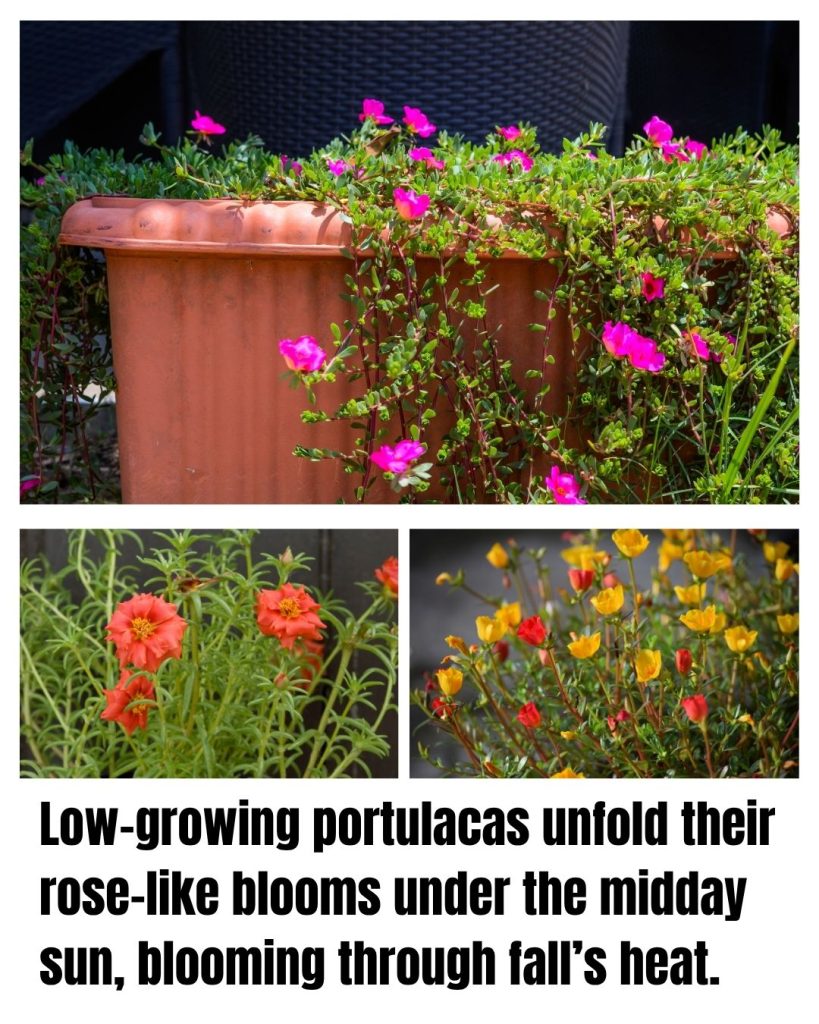
- Succulent leaves store water for heat waves.
- Sunny-day blooms that open wide at midday.
- Thrives in lean, sandy soils and rock edges.
Portulaca is a go-to for blistering spots where hoses can’t reach. It creeps into a colorful mat, spilling over borders and bowls. Mix several colors for a quilt effect.
Texas timing: Plant July–September. In the Valley and Coastal Bend, it can push late into fall until a real cold snap.
Water & soil: Full sun, sharp drainage, very light water. Overwatering ends the party. Avoid heavy clay unless it’s bermed and amended.
Where it shines: Rock gardens, curb strips, mailbox beds, and wall planters baking in reflected heat.
8. Annual Salvia / Mealycup Sage (Salvia farinacea)

- Spiky blue-violet wands for height and rhythm.
- Hummingbird and bee favorite.
- Reblooms when clipped lightly.
Native to Texas in wild forms, mealycup sage is right at home in late sun. It provides vertical lines that balance softer daisies and mounding annuals.
Texas timing: Transplant July–September statewide. In the far south it can overwinter and act like a short-lived perennial.
Water & soil: Full sun, average soil, decent drainage. Tolerates alkaline sites. Water weekly to establish, then reduce.
Where it shines: Mixed borders, pollinator gardens, church grounds, and school beds that need dependable structure.
9. Vinca / Madagascar Periwinkle (Catharanthus roseus)
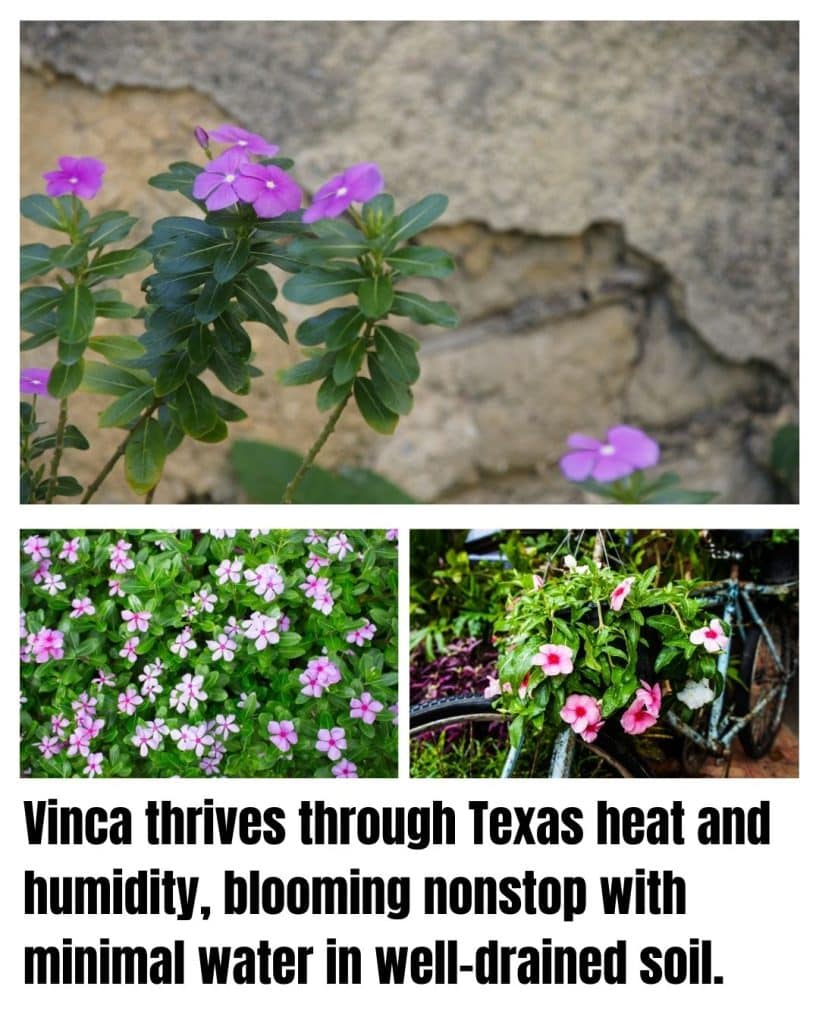
- Heat-and-drought champ when many flowers stall.
- Continuous bloom in white, pink, red, and bicolors.
- Low care with little deadheading needed.
When dahlias sulk in Texas heat, vinca keeps smiling. It’s unbeatable for medians, hot foundations, and big swaths of color you can see from the street.
Texas timing: Plant July–September. In South TX, it often flowers right into winter unless there’s a hard freeze.
Water & soil: Full sun, well-drained beds, light but regular watering until roots run. Avoid chronically wet sites to prevent root rot.
Where it shines: Mass plantings, mailbox clusters, and low-care rental properties needing steady curb appeal.
10. Rudbeckia (Annual Black-Eyed Susan Types)
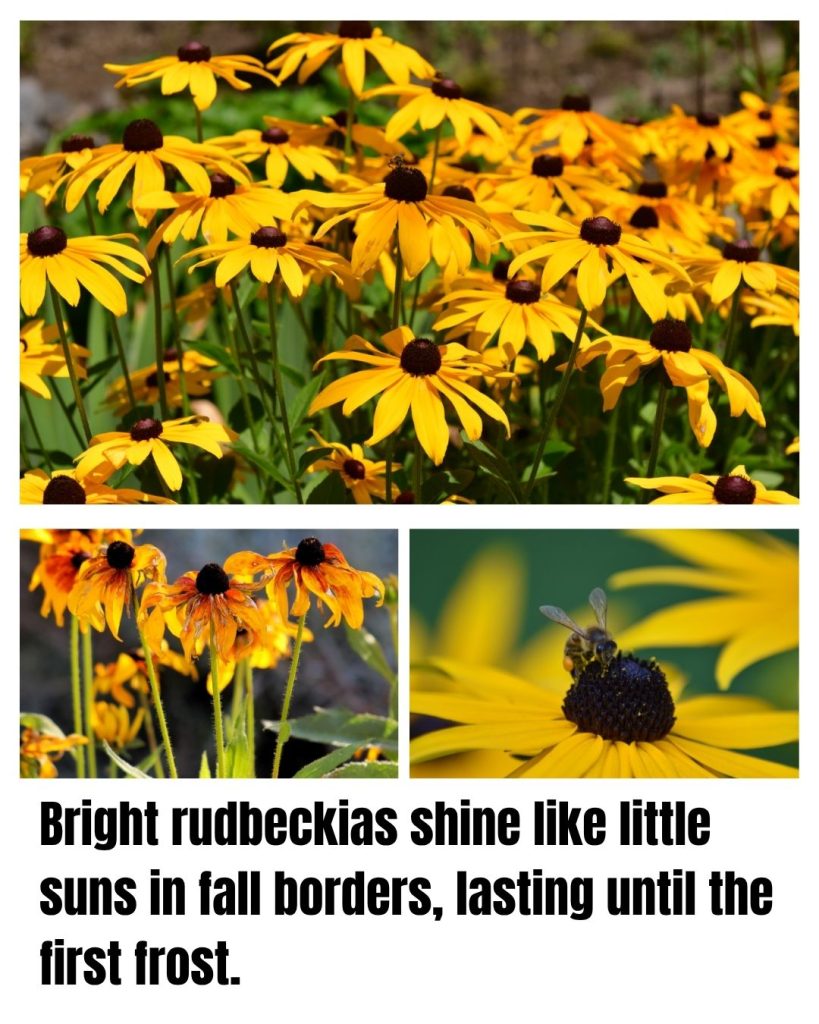
- Golden petals with dark centers shout “fall.”
- Heat tolerant and sun loving.
- Long bloom to frost with deadheading.
Use annual rudbeckias to bridge summer into fall. They play nicely with blue salvias and rosy sedums, delivering that classic prairie palette.
Texas timing: Plant July-September. In North TX, start by mid-August for a strong show before frost.
Water & soil: Full sun, average soil, deep but infrequent watering. Mulch to keep roots even through hot spells.
Where it shines: Mass plantings, mailbox beds, and entries that need a big, warm welcome.
11. Lantana (Lantana camara & L. urticoides)
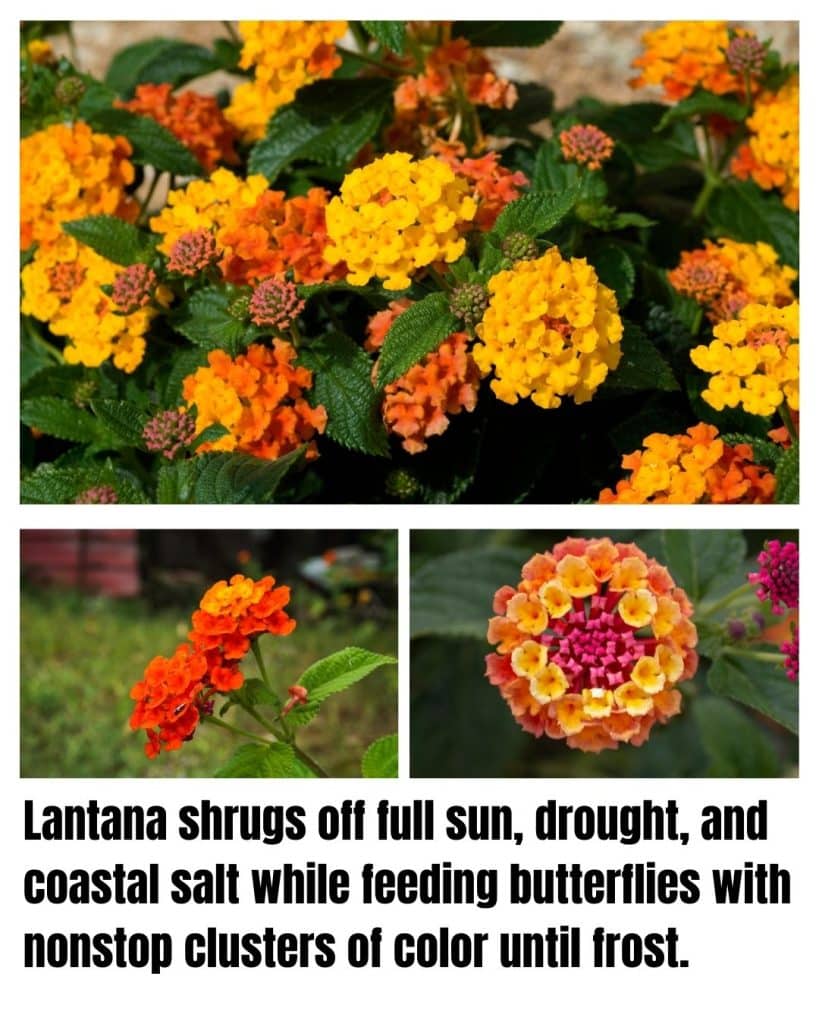
- Sunset clusters nonstop in high heat.
- Drought and salt tolerant– great on the coast.
- Butterflies love it, all season long.
North and Central TX often grow lantana as an annual; South TX treats it like a perennial shrub. Choose mounding types for beds and trailing types for spilling planters.
Texas timing: Plant July through September. It keeps going until frost; in frost-free pockets it can flower into winter.
Water & soil: Full sun, fast drainage, and light feeding. Cut back midseason if plants get woody to trigger fresh bloom.
Where it shines: Street medians, coastal gardens, mailbox islands, and large containers that roast in afternoon sun.
12. Sunflower (Dwarf Varieties)
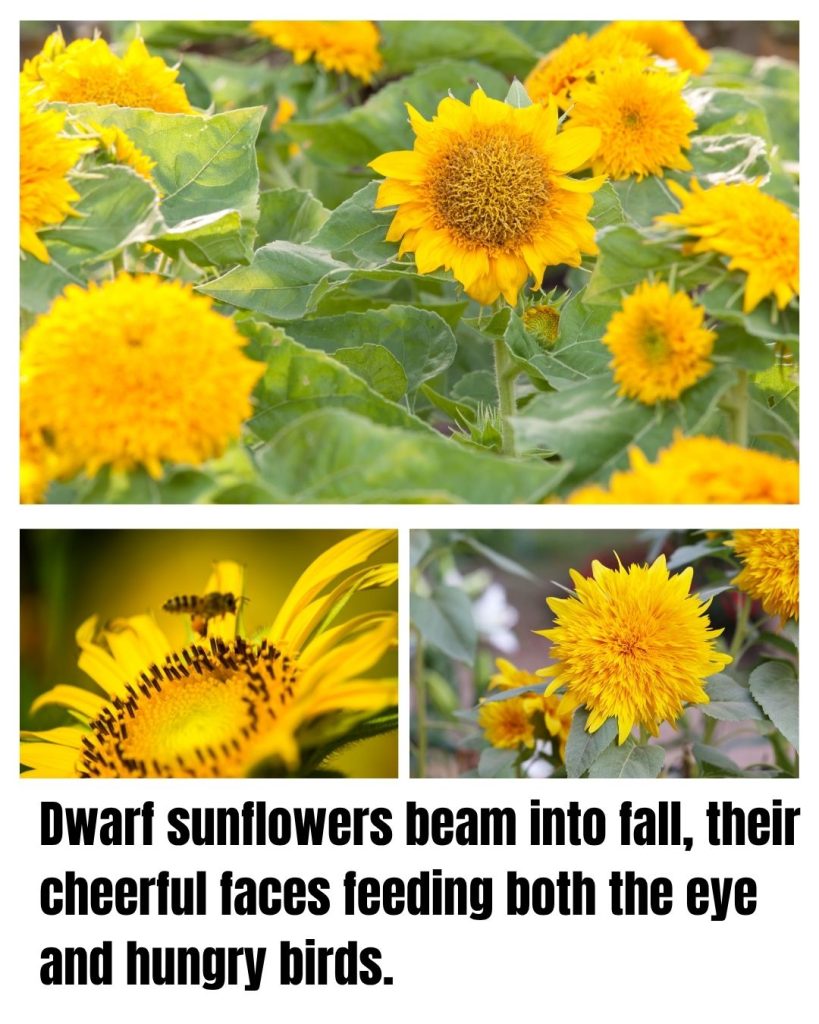
- Compact height for borders and pots.
- Late-season faces from August into fall.
- Bird-friendly seed after bloom.
Dwarf sunflowers deliver the happy look without the wind issues of tall giants. Plant in waves every 2–3 weeks for a rolling show into November in South TX.
Texas timing: Sow/plant July-September (earlier in North TX). Choose quick 50-60 day varieties for late windows.
Water & soil: Full sun, moderate water, decent drainage. Shelter from blasting Panhandle winds if possible.
Where it shines: Kids’ plots, roadside fences, and wildlife corners where you’ll leave some heads for finches.
Perennials
13. Fall Aster (Symphyotrichum oblongifolium)
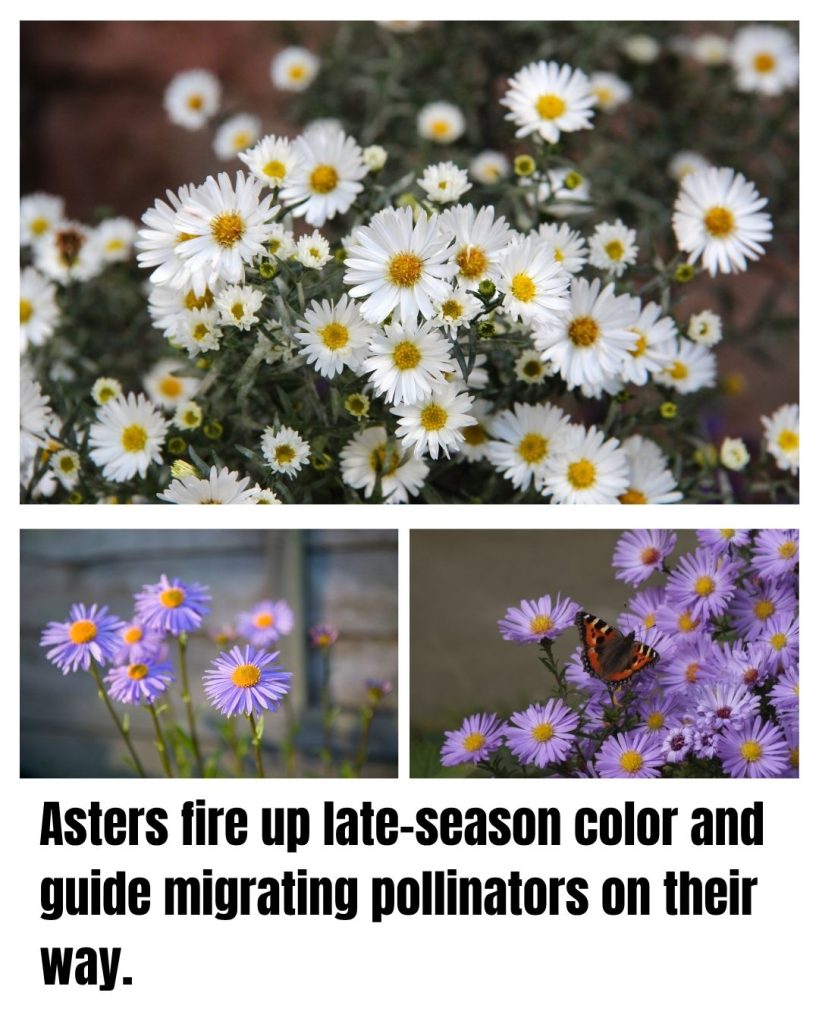
- Sheets of purple daisies in October–November.
- Monarch support during migration.
- Low maintenance and drought adapted.
A Texas native that wakes up right when the garden needs a second wind. It forms mounds that burst into bloom almost overnight. Shear once in early summer for a tighter, floriferous plant.
Texas timing: Plant spring or late summer/early fall. It establishes well with warm soil and cooler nights.
Water & soil: Full sun to part sun. Handles thin Hill Country soils, but appreciates a seasonal compost top-dress.
Where it shines: Native beds, cottage borders, parkways, and wildlife gardens needing late nectar.
14. Sedum ‘Autumn Joy’ (Hylotelephium telephium)
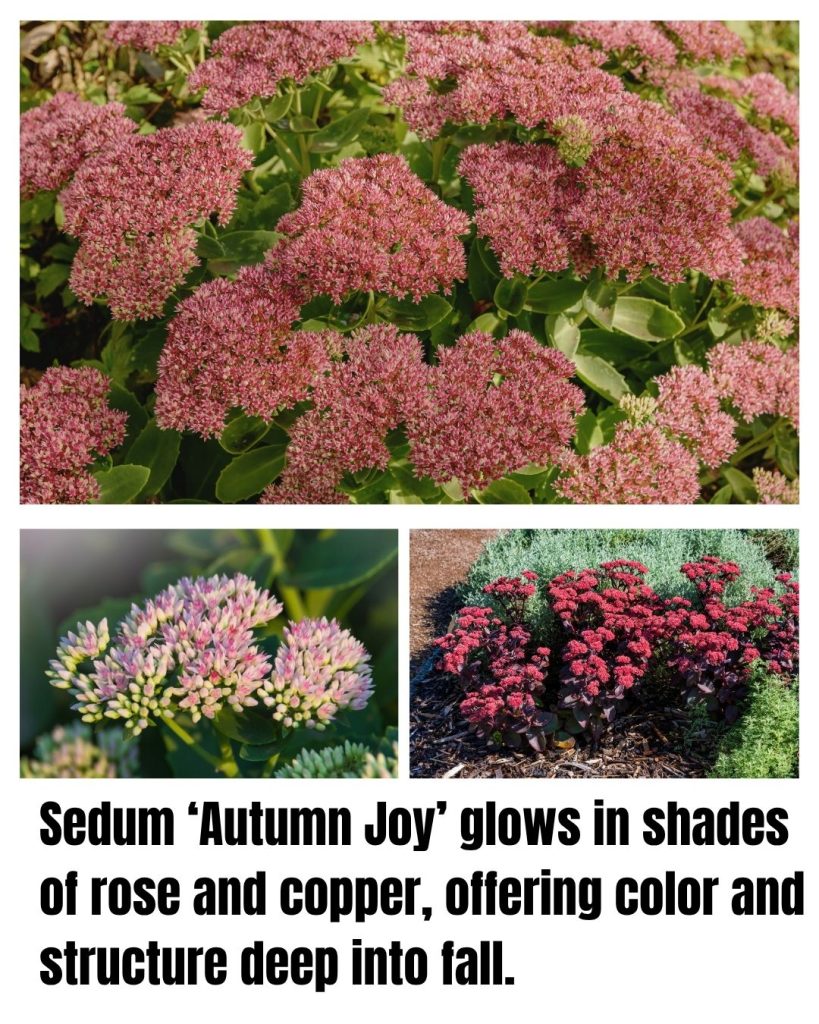
- Rose-pink domes aging to copper and russet.
- Highly drought tolerant with succulent leaves.
- Winter interest from seed heads.
This sedum thrives in lean, bright sites where other perennials fade. Leave seed heads for winter texture, then cut back in early spring as new rosettes appear.
Texas timing: Plant any time the ground is workable; late summer through fall is excellent as heat eases.
Water & soil: Full sun and drainage are non-negotiable. Overly rich soil causes flop; go easy on fertilizer.
Where it shines: Xeric beds, mailbox berms, and modern landscapes needing structure that doesn’t need coddling.
15. Chrysanthemum (Garden Mum)
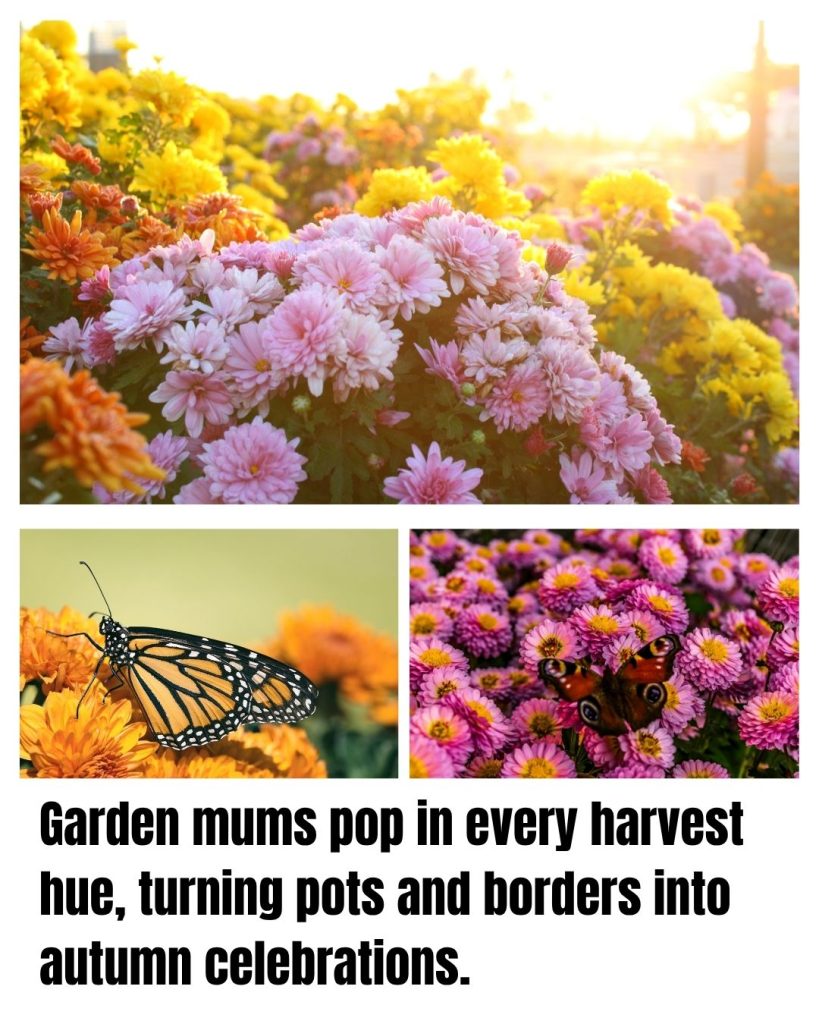
- Classic fall colors from apricot to burgundy.
- Many forms for beds, steps, and pots.
- Late nectar for bees in warm spells.
Garden mums deliver instant football-season cheer. For true perennial performance in Texas, plant in the ground early and pinch through summer; those big box pots can be treated as seasonal color if you’re short on time.
Texas timing: Set out in late summer for fall bloom. In South TX, late fall plantings can overwinter if well mulched.
Water & soil: Full sun, rich but well-drained soil, and even moisture. Avoid waterlogging during Gulf downpours.
Where it shines: Porches, entry pots, and curb-appeal refreshes heading into the holidays.
16. Coneflower (Echinacea purpurea)
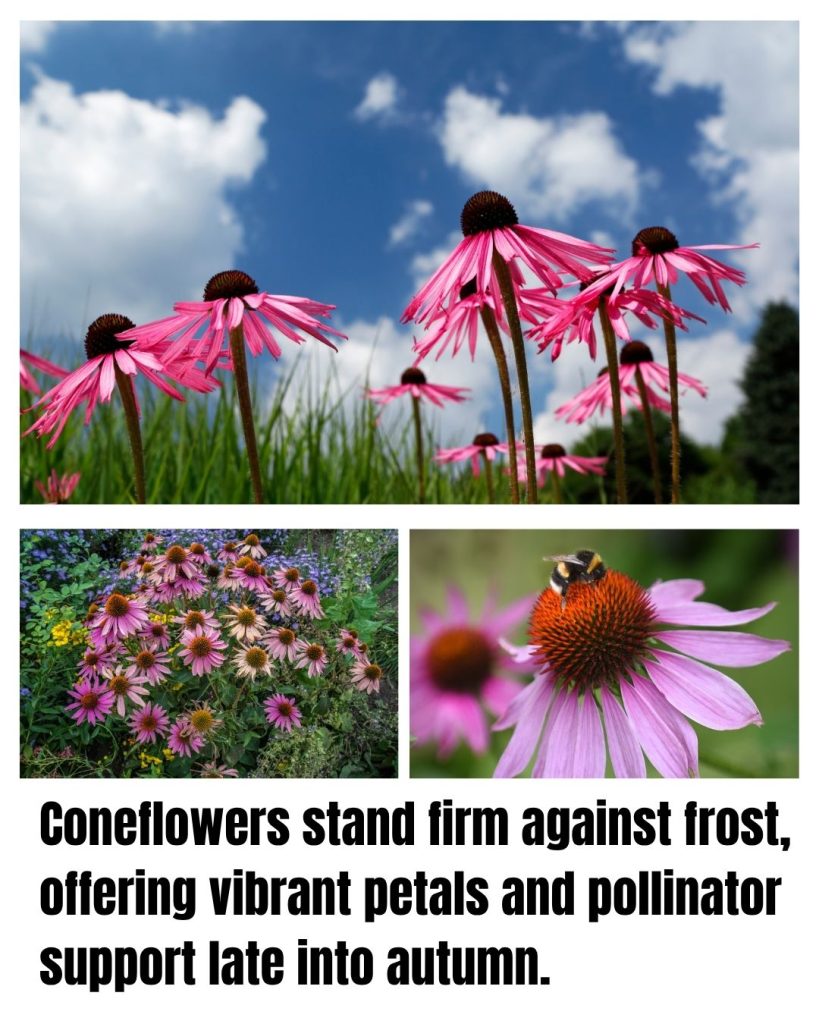
- Tough prairie daisy from midsummer to frost.
- Drought adapted once established.
- Bird-friendly seedheads in fall/winter.
Few perennials are as Texas-reliable as coneflower. It holds upright in heat, mixes with natives, and reblooms if you clip spent petals through late summer.
Texas timing: Plant spring or fall. Late summer installs are fine if you water to establish and mulch well.
Water & soil: Full sun to light shade; average, well-drained soil. Very forgiving in alkaline areas.
Where it shines: Pollinator gardens, prairie mixes, and front-yard beds with a natural, low-care look.
17. Helenium (Sneezeweed)

- Warm-toned daisies in yellow, orange, and red.
- Late food for butterflies and bees.
- Sturdy stems that resist wind and rain.
Helenium thrives where it gets water in summer and sun all day. The warm tones are perfect with blue salvias and purple asters in October light.
Texas timing: Plant spring or fall; late summer works with steady irrigation.
Water & soil: Full sun and consistently moist, well-drained soil. Add compost in thin prairie soils.
Where it shines: Irrigated borders, rain-fed swales with good drainage, and big perennial beds needing saturated color late in the year.
18. Black-Eyed Susan (Rudbeckia fulgida)
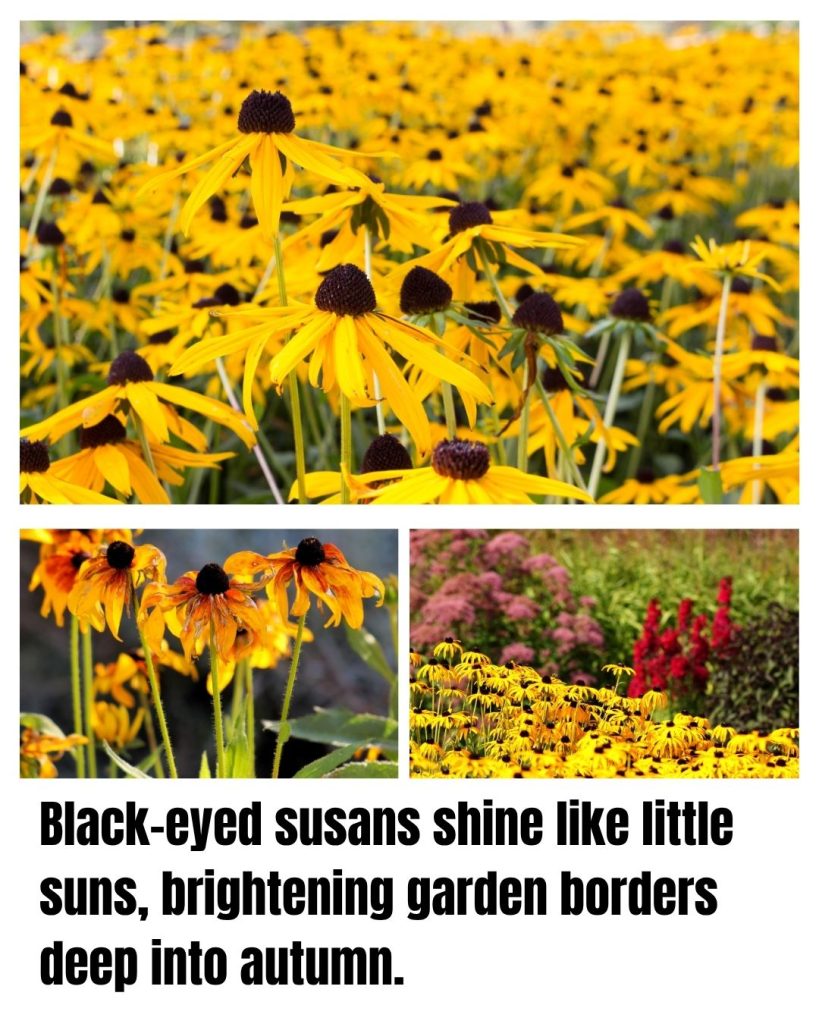
- Golden rays with dark cones for months.
- Deer resistant foliage.
- Naturalizes in friendly garden soils.
This perennial version of the classic daisy brings durable color through late heat. Let some seed heads mature to feed birds and gently expand the colony.
Texas timing: Plant spring or fall for best take-off. Late summer is fine with mulch and water.
Water & soil: Full sun, average soil, deep watering during long dry spells. Cut back in late winter.
Where it shines: Prairie mixes, mailbox beds, and broad sweeps along fences with coneflower and fall aster.
19. Goldenrod (Solidago spp.)
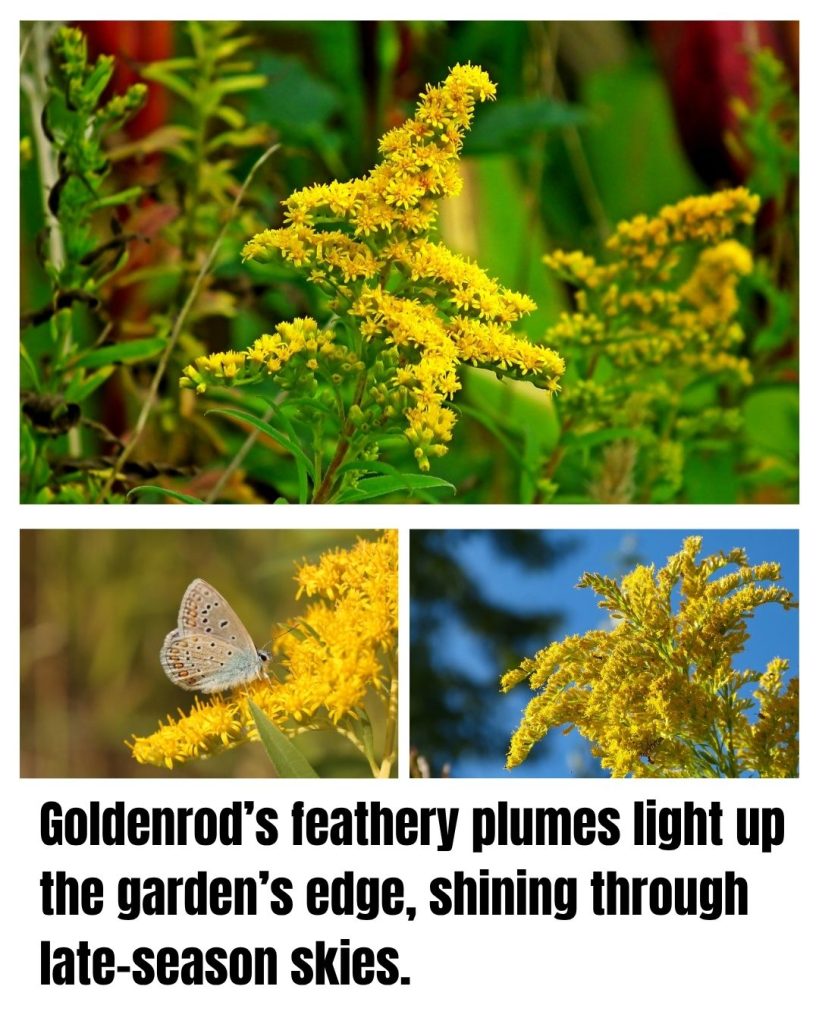
- Feathery plumes of gold for back borders.
- Wildlife value for late-season nectar and seed.
- Tough and resilient in poor soils.
Several Texas native goldenrods thrive in sun and thin soils. They’re a backbone plant for fall color and pollinator support. Choose clump-forming species in small gardens to avoid thuggish spreaders.
Texas timing: Plant spring or fall. Divide or thin clumps every few years to keep stands vigorous.
Water & soil: Full sun, good drainage. Very drought-tolerant once established. Minimal fertilizer needed.
Where it shines: Prairie beds, wildlife strips, and back fences where tall, airy color won’t block views.
20. Russian Sage (Perovskia atriplicifolia)
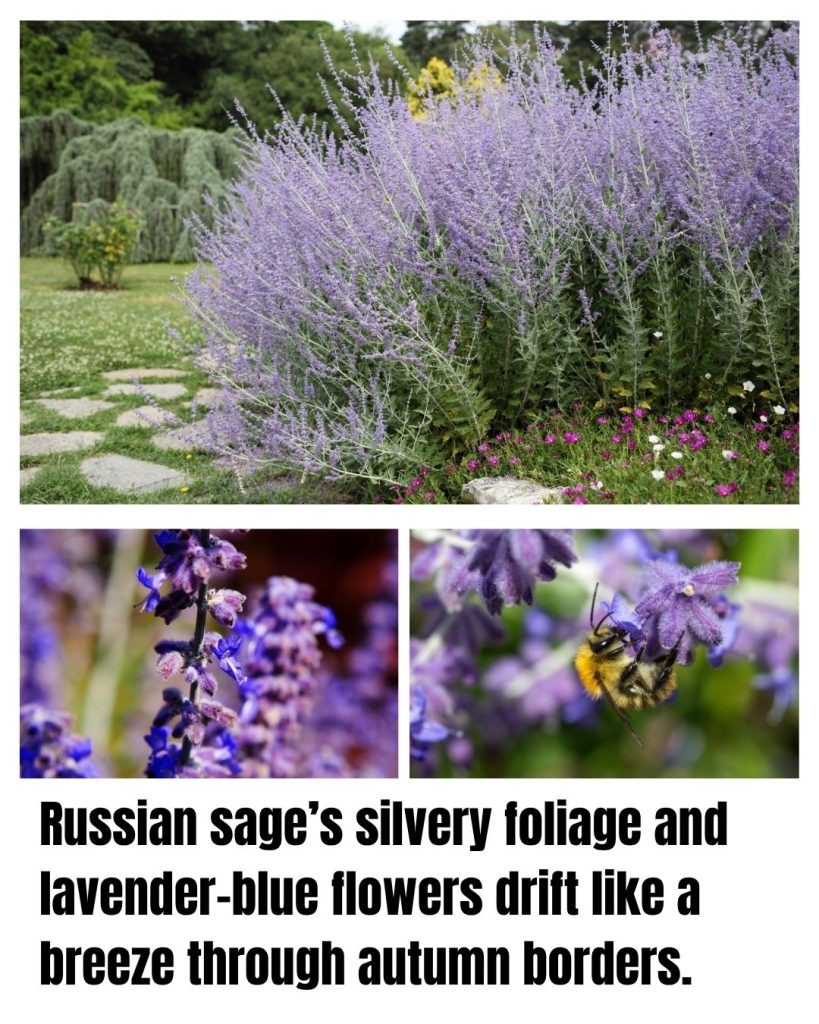
- Lavender-blue haze over silvery stems.
- Heat and drought tolerant for sun-blasted sites.
- Pollinator rich with long bloom.
Airy, elegant, and easy, Russian sage weaves through warm-colored daisies and ornamental grasses. Cut back hard in early spring to a low framework for tidy new growth.
Texas timing: Plant fall for best establishment; late summer works with mulch and a couple of deep waterings.
Water & soil: Full sun and drainage. Overly rich soil reduces the airy habit; keep it lean and bright.
Where it shines: Hot reflected sites, gravel gardens, and Mediterranean-style designs across the state.
21. Bluebeard (Caryopteris × clandonensis)
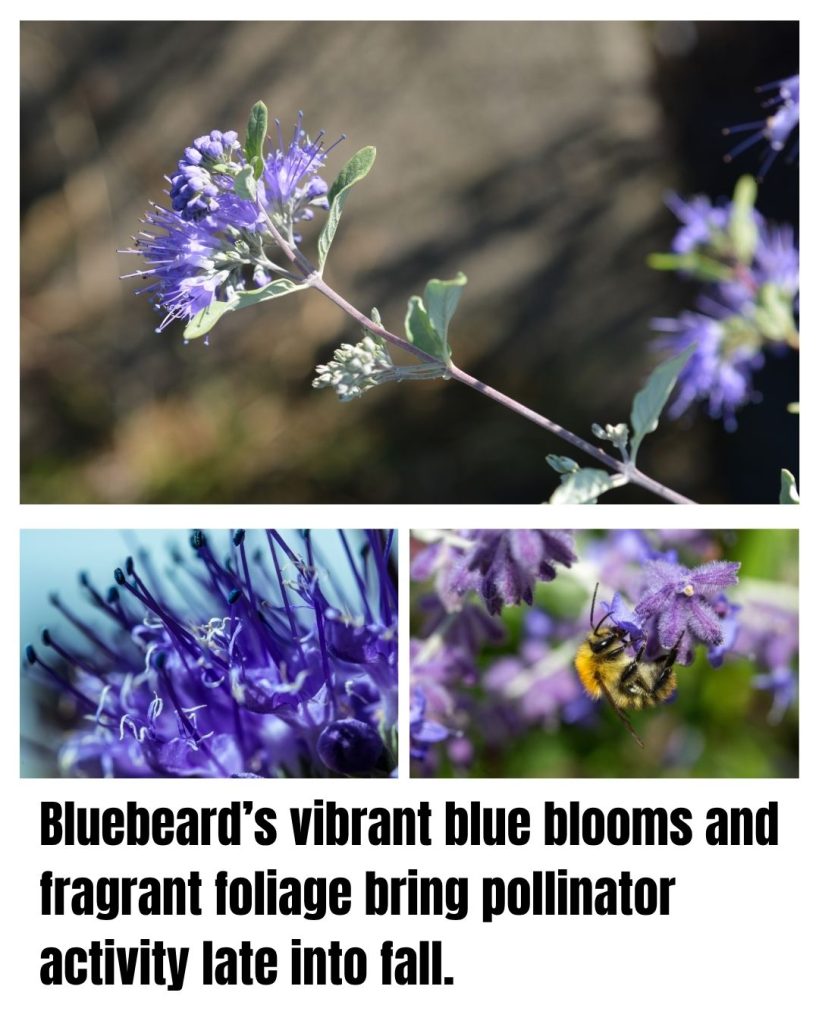
- Sky-blue clusters in late summer and fall.
- Bees and hummingbirds flock to it.
- Fast and forgiving in hot sun.
Bluebeard is a small, woody subshrub with gray-green leaves and true-blue flowers right when you want them. Shear after first bloom to trigger a second flush.
Texas timing: Plant spring or fall; late summer is fine with regular water to establish.
Water & soil: Full sun, drainage, and modest water needs once rooted. Avoid heavy clay without amendment or berming.
Where it shines: Foundation beds, mixed borders, and as a blue foil to warm daisies and copper sedums.
22. Gregg’s Mistflower (Conoclinium greggii)
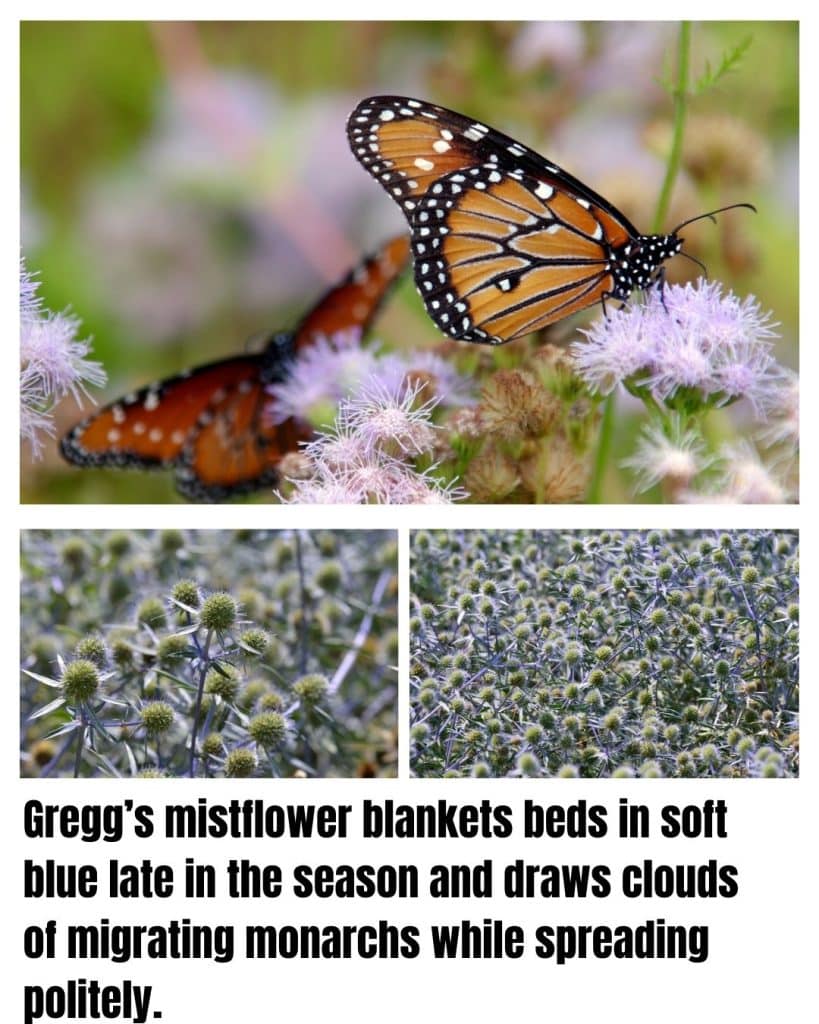
- Soft blue tufts from late summer into fall.
- Monarch magnet along migration routes.
- Texas native that spreads gently.
This low, colony-forming perennial is a secret weapon for fall butterfly traffic. It creeps politely and weaves between taller plants, filling gaps with cool blue.
Texas timing: Plant spring or fall. Late summer installs take if you keep it watered the first month.
Water & soil: Full sun to part sun; moderate moisture. It tolerates clay if not waterlogged and thrives in loam with mulch.
Where it shines: Along fences, in parkway strips, under taller salvias, and near patios where you can watch the butterflies.
23. Mexican Bush Sage (Salvia leucantha)
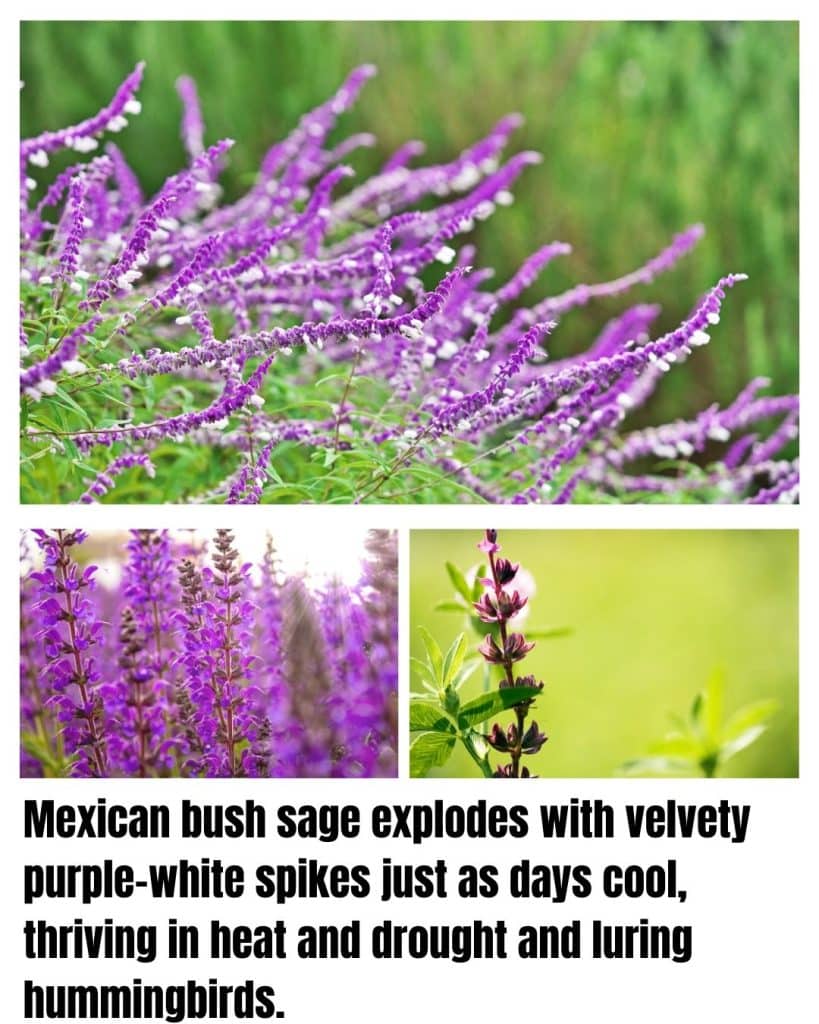
- Velvety purple-white wands in fall.
- Hummingbird favorite in warm spells.
- Heat and drought tolerant once settled.
This showy salvia earns its keep just as days shorten. The fuzzy blooms look great with tithonia and ornamental grasses. Cut back hard in late winter; it rebounds fast in spring.
Texas timing: Plant spring or fall; in North TX, mulch crowns for winter. South TX often keeps it evergreen.
Water & soil: Full sun, drainage, light feeding. Too much water makes it floppy.
Where it shines: Large beds, sunny corners, and as a seasonal anchor near entries and mailboxes.
24. Autumn Sage (Salvia greggii)
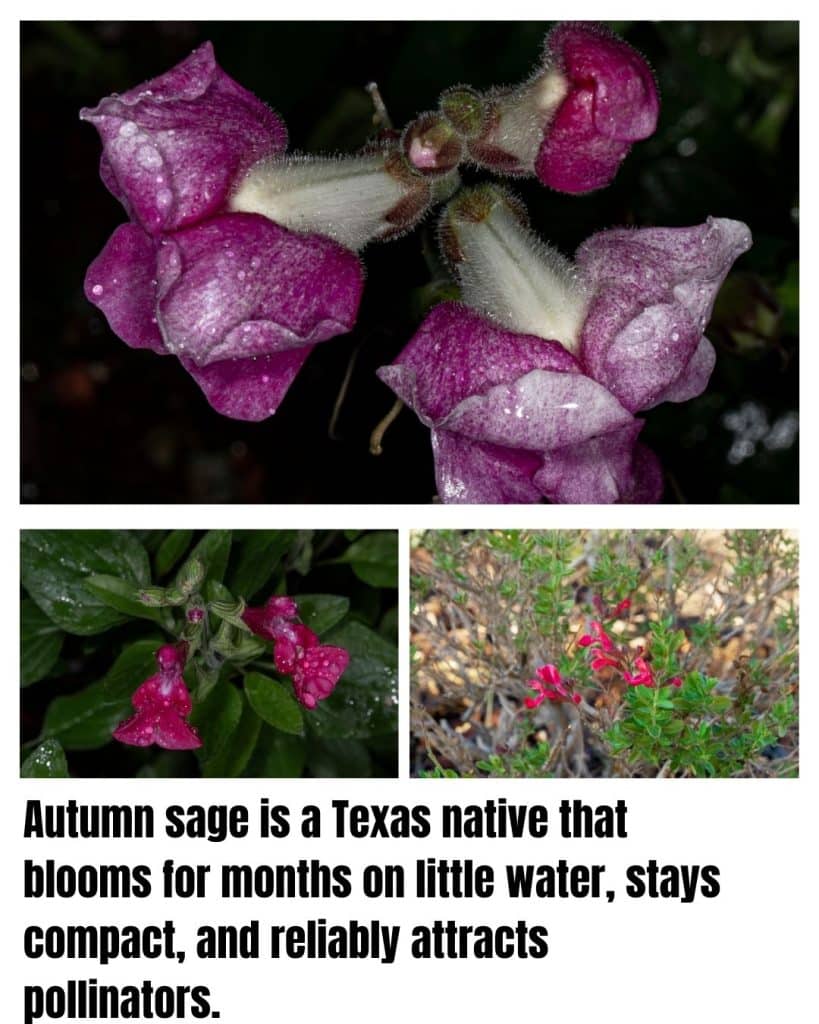
- Cherry reds, corals, and salmons for months.
- Drought wise and deer tolerant.
- Compact habit fits small spaces.
A Texas native workhorse, autumn sage blooms on and off from spring to frost, peaking again as nights cool. Lightly shear after flushes to keep flowers coming.
Texas timing: Plant spring or fall, or late summer with a week or two of steady water.
Water & soil: Full sun, draining soil, low to moderate water. Excellent in alkaline limestone areas.
Where it shines: Foundation beds, mailbox islands, native xeric plantings, and the front edge of mixed borders.
25. Maximilian Sunflower (Helianthus maximiliani)

- Late golden daisies on tall, arching stems.
- Texas native that handles wind and sun.
- Wildlife friendly with seed for birds.
This prairie native rises late and throws a curtain of fall color that waves in the breeze. Give it room or a back-of-bed spot where it can lean with the wind and still look graceful.
Texas timing: Plant spring or fall. Late summer is fine if you water to establish. It returns stronger each year.
Water & soil: Full sun, average soil. Stake if you’re in a very exposed, windy site. Cut to the ground in late winter.
Where it shines: Meadows, acreage edges, wildlife corridors, and the sunny side of privacy fences.
Texas planting quick notes:
For late-season color, many of these can be installed from late July through September. North Texas should aim earlier; South Texas can plant later.
Use 2–3 inches of mulch, water deeply at planting, and shade new transplants during the first week of extreme heat if needed.
In Hurricane-prone coastal areas, stake tall growers like tithonia and Maximilian sunflower, and improve drainage with berms or raised beds to get roots above temporary standing water.
Soil tips by region:
- Hill Country: add compost to thin limestone soils and choose drainage-lovers like salvias, sedum, and Russian sage.
- Blackland Prairie/DFW: loosen clay with compost and expanded shale for annuals like zinnia and cosmos.
- Gulf Coast: favor salt-tolerant and humidity-tough picks such as lantana, vinca, mealycup sage, and gomphrena.
- High Plains/Panhandle:windbreaks help tall bloomers; water deeply but less often to encourage deep roots.
Heat-wave care:
Water early morning, not lightly at dusk. Deep soaks every 4–7 days beat daily sprinkles. Use 30–40% shade cloth for the first week after planting during extreme heat, then remove to keep blooms coming.
Deadhead weekly and feed lightly with a balanced, slow-release fertilizer at planting; most of these bloom better on the lean side.